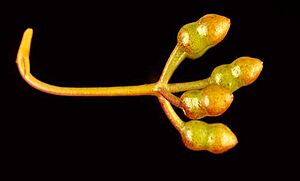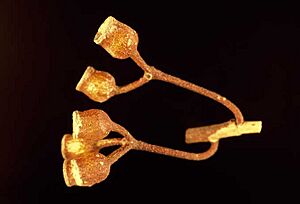Cherry-fruited mallee facts for kids
Quick facts for kids Cherry-fruited mallee |
|
|---|---|
 |
|
| Conservation status | |
| Scientific classification | |
| Genus: |
Eucalyptus
|
| Species: |
cerasiformis
|
The cherry-fruited mallee (Eucalyptus cerasiformis) is a special type of eucalypt tree. It's called a "mallee" because it has many stems growing from a woody base at ground level. This plant is only found in a small part of Western Australia.
It has smooth, pale grey bark that can sometimes look powdery. Its leaves are long and narrow, shaped like a spear. The flowers are pale yellow or whitish, and they grow in groups of seven. After the flowers, it produces interesting fruit that look like small bells or cylinders.
Contents
What Does the Cherry-Fruited Mallee Look Like?
The cherry-fruited mallee usually grows to be about 2 to 3.5 meters (6.5 to 11.5 feet) tall. It has smooth bark that is pale grey and white, and sometimes it looks like it's covered in powder.
Leaves, Buds, and Flowers
Its adult leaves are thin and shiny, with a grey-green color on both sides. They are shaped like a narrow spear, about 5 to 11 centimeters (2 to 4.4 inches) long and 0.5 to 1.4 centimeters (0.2 to 0.5 inches) wide. Each leaf has a stalk called a petiole, which is about 0.8 to 2 centimeters (0.3 to 0.8 inches) long.
The flower buds grow in groups of seven. They hang from a thin stalk called a peduncle, which is about 1.8 to 5 centimeters (0.7 to 2 inches) long. Each individual bud is on a smaller stalk called a pedicel, about 0.7 to 1.6 centimeters (0.3 to 0.6 inches) long. When the buds are ready to open, they are mostly cylindrical, about 0.9 to 1.1 centimeters (0.35 to 0.43 inches) long and 0.5 to 0.6 centimeters (0.2 to 0.24 inches) wide. They have a cone-shaped or rounded cap on top with a small point.
This mallee blooms between December and March. Its flowers are a pale yellow or whitish color.
Fruit
After flowering, the plant produces fruit. These are woody capsules that can be cylindrical, bell-shaped, urn-shaped, or even like half a sphere.
How Was it Named?
The cherry-fruited mallee was first officially described in 1978. Two scientists, Ian Brooker and Donald Frederick Blaxell, wrote about it after Donald Blaxell found a sample near the Hyden - Norseman Road in Western Australia.
The scientific name, cerasiformis, comes from two Latin words: cerasus, which means "cherry-tree," and -formis, which means "shape." This name was chosen because the hanging flower buds look a bit like a bunch of cherries.
Where Does it Live?
The cherry-fruited mallee is only known to grow in one specific place. This area is just north of Lake Johnston in Western Australia. It grows in low, open forests where the soil is red and loamy.
Is it Protected?
The Government of Western Australia's Department of Parks and Wildlife has classified this eucalypt as "Priority Four." This means it is rare or close to being threatened, so it needs special attention to protect it.




